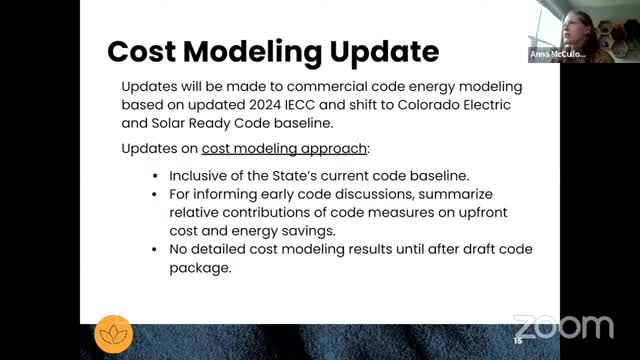Colorado energy code updates reduce costs but increase efficiency requirements for buildings
April 27, 2025 | Energy Office, State Agencies, Organizations, Executive, Colorado
This article was created by AI summarizing key points discussed. AI makes mistakes, so for full details and context, please refer to the video of the full meeting. Please report any errors so we can fix them. Report an error »

In a pivotal meeting held by the Colorado Energy Office, stakeholders gathered to discuss the latest updates to the Energy Code Board's Low Energy and Carbon Code. The atmosphere was charged with anticipation as participants delved into the intricacies of energy modeling for various building types, including multifamily units, offices, and single-family homes. The focus was on ensuring that these models accurately reflect the most common construction practices across Colorado's diverse climate zones.
One of the key discussions centered on the importance of incorporating a broader range of climate data into energy modeling. Participants emphasized that relying solely on front-range models could overlook significant variations in construction costs and energy efficiency across the state. This acknowledgment of Colorado's varied geography and climate was a crucial step toward creating a more inclusive and effective energy code.
As the meeting progressed, the conversation shifted to the 2024 residential code updates. Notably, the removal of certain provisions—specifically those related to electric readiness, solar readiness, and EV charging—was highlighted as a significant change. This adjustment is expected to lead to a notable reduction in construction costs per square foot for both multifamily and office buildings. However, the implications of these changes raised questions about the long-term impact on energy efficiency and sustainability.
Participants also discussed the new requirements for energy efficiency in residential buildings. The code now mandates that homes with on-site fuel-burning appliances achieve a 20% annual energy cost savings compared to baseline designs, while all-electric homes are required to meet a slightly lower threshold of 15%. These measures reflect a growing trend toward prioritizing energy efficiency and reducing carbon footprints in residential construction.
The meeting also addressed the introduction of a point system for additional energy-saving measures, which requires homes to achieve a total of 10 credits through various efficiency packages. This shift from a single-package requirement to a more flexible point system aims to encourage innovation and adaptability in energy-efficient building practices.
As the discussions wrapped up, participants expressed a shared commitment to refining the code further, ensuring it aligns with both environmental goals and the practical realities of construction in Colorado. The meeting underscored the importance of collaboration among stakeholders to navigate the complexities of energy efficiency and sustainability in the state's evolving building landscape. With these updates, Colorado is poised to take significant strides toward a more energy-efficient future, balancing economic considerations with environmental responsibility.
One of the key discussions centered on the importance of incorporating a broader range of climate data into energy modeling. Participants emphasized that relying solely on front-range models could overlook significant variations in construction costs and energy efficiency across the state. This acknowledgment of Colorado's varied geography and climate was a crucial step toward creating a more inclusive and effective energy code.
As the meeting progressed, the conversation shifted to the 2024 residential code updates. Notably, the removal of certain provisions—specifically those related to electric readiness, solar readiness, and EV charging—was highlighted as a significant change. This adjustment is expected to lead to a notable reduction in construction costs per square foot for both multifamily and office buildings. However, the implications of these changes raised questions about the long-term impact on energy efficiency and sustainability.
Participants also discussed the new requirements for energy efficiency in residential buildings. The code now mandates that homes with on-site fuel-burning appliances achieve a 20% annual energy cost savings compared to baseline designs, while all-electric homes are required to meet a slightly lower threshold of 15%. These measures reflect a growing trend toward prioritizing energy efficiency and reducing carbon footprints in residential construction.
The meeting also addressed the introduction of a point system for additional energy-saving measures, which requires homes to achieve a total of 10 credits through various efficiency packages. This shift from a single-package requirement to a more flexible point system aims to encourage innovation and adaptability in energy-efficient building practices.
As the discussions wrapped up, participants expressed a shared commitment to refining the code further, ensuring it aligns with both environmental goals and the practical realities of construction in Colorado. The meeting underscored the importance of collaboration among stakeholders to navigate the complexities of energy efficiency and sustainability in the state's evolving building landscape. With these updates, Colorado is poised to take significant strides toward a more energy-efficient future, balancing economic considerations with environmental responsibility.
View full meeting
This article is based on a recent meeting—watch the full video and explore the complete transcript for deeper insights into the discussion.
View full meeting
